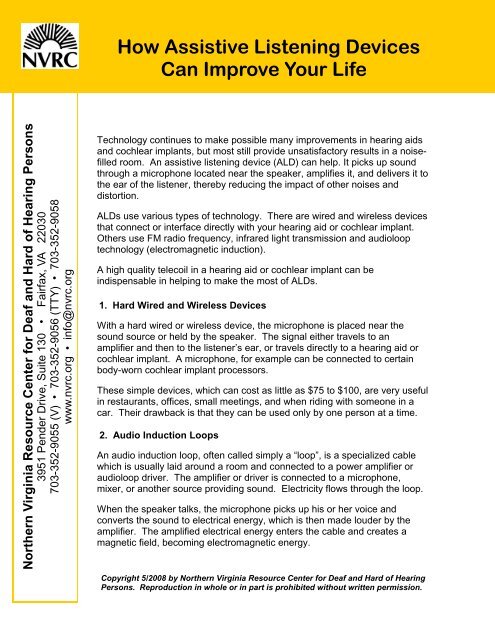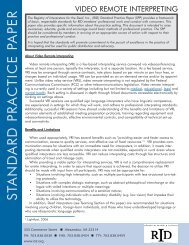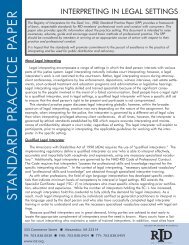How Assistive Listening Devices Can Improve Your Life - NVRC.org
How Assistive Listening Devices Can Improve Your Life - NVRC.org
How Assistive Listening Devices Can Improve Your Life - NVRC.org
You also want an ePaper? Increase the reach of your titles
YUMPU automatically turns print PDFs into web optimized ePapers that Google loves.
<strong>How</strong> <strong>Assistive</strong> <strong>Listening</strong> <strong>Devices</strong><br />
<strong>Can</strong> <strong>Improve</strong> <strong>Your</strong> <strong>Life</strong><br />
Northern Virginia Resource Center for Deaf and Hard of Hearing Persons<br />
3951 Pender Drive, Suite 130 • Fairfax, VA 22030<br />
703-352-9055 (V) • 703-352-9056 (TTY) • 703-352-9058<br />
www.nvrc.<strong>org</strong> • info@nvrc.<strong>org</strong><br />
Technology continues to make possible many improvements in hearing aids<br />
and cochlear implants, but most still provide unsatisfactory results in a noisefilled<br />
room. An assistive listening device (ALD) can help. It picks up sound<br />
through a microphone located near the speaker, amplifies it, and delivers it to<br />
the ear of the listener, thereby reducing the impact of other noises and<br />
distortion.<br />
ALDs use various types of technology. There are wired and wireless devices<br />
that connect or interface directly with your hearing aid or cochlear implant.<br />
Others use FM radio frequency, infrared light transmission and audioloop<br />
technology (electromagnetic induction).<br />
A high quality telecoil in a hearing aid or cochlear implant can be<br />
indispensable in helping to make the most of ALDs.<br />
1. Hard Wired and Wireless <strong>Devices</strong><br />
With a hard wired or wireless device, the microphone is placed near the<br />
sound source or held by the speaker. The signal either travels to an<br />
amplifier and then to the listener’s ear, or travels directly to a hearing aid or<br />
cochlear implant. A microphone, for example can be connected to certain<br />
body-worn cochlear implant processors.<br />
These simple devices, which can cost as little as $75 to $100, are very useful<br />
in restaurants, offices, small meetings, and when riding with someone in a<br />
car. Their drawback is that they can be used only by one person at a time.<br />
2. Audio Induction Loops<br />
An audio induction loop, often called simply a “loop”, is a specialized cable<br />
which is usually laid around a room and connected to a power amplifier or<br />
audioloop driver. The amplifier or driver is connected to a microphone,<br />
mixer, or another source providing sound. Electricity flows through the loop.<br />
When the speaker talks, the microphone picks up his or her voice and<br />
converts the sound to electrical energy, which is then made louder by the<br />
amplifier. The amplified electrical energy enters the cable and creates a<br />
magnetic field, becoming electromagnetic energy.<br />
Copyright 5/2008 by Northern Virginia Resource Center for Deaf and Hard of Hearing<br />
Persons. Reproduction in whole or in part is prohibited without written permission.
A hearing aid or cochlear implant with a telecoil can pick up this electromagnetic<br />
energy and send it to the receiver of the hearing aid or cochlear implant, where it is<br />
converted to sound.<br />
Loops come in various sizes. Often they are installed in the walls, floors, or ceilings<br />
of meeting rooms. Portable loops can be temporarily set up for meetings and then<br />
disassembled. They can be used around a chair, desk, or dining room table.<br />
There are also neckloops for individual use with all the other types of ALDs.<br />
Because loops can provide clear sound to a hearing aid or cochlear implant, a<br />
neckloop will often be the preference for use with any hard wired ALD. If your<br />
hearing aid or cochlear implant does not have a telecoil switch, you can use a<br />
personal loop receiver or, in the case of certain cochlear implants, a telecoil adapter<br />
that attaches to, or is contained in, your processor. While headsets are provided by<br />
most systems, they bypass use of your hearing aid and cochlear implant, so you will<br />
not have the advantage of using them at maximum efficiency.<br />
3. Infrared<br />
In this wireless system, sound is transmitted via invisible infrared light waves. A<br />
transmitter or emitter sends the signal to a receiver, which picks up the signal and<br />
converts it back to sound. This is a line-of-sight system. To use it, you must be<br />
positioned where the receiver can pick up the signal transmission, or where the<br />
signal is reflected.<br />
While infrared systems continue to improve, they can still be ineffective in sunlight.<br />
Infrared systems are available for areas ranging from a small room to a large one.<br />
The listener may use earphones or a neckloop with the receiver. Some cochlear<br />
implants can connect directly to the receiver with a patch cord or other device.<br />
Receivers have a volume control. There are two types of infrared receivers:<br />
body-pack style and headphone. If a neckloop is used, the hearing aid or cochlear<br />
implant must be at the telecoil setting. These systems are usually used in theaters,<br />
courtrooms, and auditoriums.<br />
4. FM<br />
FM (frequency modulation) systems use radio waves to transmit sound in the 72 to<br />
76 megaHertz frequency range. A transmitter must be connected to a microphone,<br />
and each listener must have a receiver with a headset or a neckloop. FM systems<br />
are used in auditoriums, places of worship, classrooms, theaters, and performances<br />
at outdoor facilities such as Wolf Trap Center for the Performing Arts.<br />
Personal FM systems are used for meetings where the speaker is too far away for<br />
the use of a hard wired device. FM systems can also be used almost everywhere<br />
that a hard wired device is used. Although more costly than hard wired devices,<br />
2
they have some advantages. They permit greater flexibility because nearness to<br />
the speaker is not a requirement.<br />
Attachments for ALDs<br />
Attachments for use with ALDs include headphones, earbuds, silhouettes,<br />
neckloops, and cochlear implant patch cords or adapters. People with hearing loss<br />
will prefer one accessory over another, depending on the nature of their individual<br />
hearing loss. Those who frequently use ALDs will want to acquire their own<br />
attachments, especially if they use headphones or earpieces, to minimize potential<br />
spread of disease.<br />
Purchasing <strong>Assistive</strong> <strong>Listening</strong> <strong>Devices</strong> and Attachments<br />
When considering the purchase of an ALD, you will want to evaluate the company<br />
or individual. Some questions to ask are:<br />
• What are the seller’s qualifications, and how long has the company been in<br />
business?<br />
• Does the seller often sell these devices?<br />
• Does he or she attend trainings to keep abreast of the latest technology<br />
information?<br />
• What are the payment terms, return policies, and warranty terms?<br />
• What is the device manufacturer’s reputation?<br />
• Does the seller have the ability to service what is sold, and if so, what is the<br />
approximate repair time?<br />
• Is there a trial period before purchasing, and is a loaner device available during<br />
servicing?<br />
Talk to other consumers and ask them about their experiences with the company<br />
and the brand. The local chapters of Hearing Loss Association of America (HLAA)<br />
and Association of Late-Deafened Adults (ALDA) can be excellent resourcea. The<br />
Northern Virginia Resource Center for Deaf and Hard of Hearing Persons (<strong>NVRC</strong>)<br />
can provide contact information for these <strong>org</strong>anizations.<br />
Sources of ALDs<br />
For a list of companies that specialize in ALDs, contact <strong>NVRC</strong>. Several internet and<br />
mail order companies have catalogs containing hundreds of assistive devices.<br />
Buying a replacement item through a catalog may be satisfactory, but the initial<br />
purchase of a device through the mail may not be a good idea. If possible, get a<br />
consultation with a professional to fit you with a device and to recommend new<br />
options that may be best for you and your price range. You will want to go in and<br />
test the system, and have adjustments made if needed. Another consideration is a<br />
delay you may face if you need to mail your device back for servicing.<br />
3






